清华大学TsinghuaUniversity
清华大学毕业证样本学位证样本历任校(院)长学校代码

清华大学毕业证样本学位证样本历任校(院)长学校代码清华大学简介清华大学(外文名: Tsinghua University )简称:清华(THU或Tsinghua) 是中国著名高等学府,也是一所逐步恢复了理科、经济、管理和文科类学科的高等学校。
清华大学院系设置学校院系设置有;建筑学院、土木水利学院、环境学院、械工程学院、航天航空学院、信息科学技术学院、理学院、经济管理学院、马克思主义学院、人文社会科学学院、医学院、法学院、新闻与传播学院、五道口金融学院、美术学院、生命科学学院。
清华大学的特色专业学校设置有特色专业;材料科学与工程、电气工程、电子科学与技术、信息与通信工程、控制科学与工程、计算机科学与技术、建筑学、核科学与技术、环境科学与工程、工商管理、艺术学、管理科学与工程、动力工程及工程热物理、仪器科学与技术、光学工程 ............。
清华大学的学校前沿介绍学校前沿是 1911年成立的清政府建立的留美预备学校,1912 年由学校更名为清华学校,1928年由学校更名为国立清华大学,1937年抗日战争爆发后,南迁长沙,与北京大学、南开大学联合办学,组建国立长沙临时大学,1938年迁至昆明,改名为国立西南联合大学。
1946年清华大学迁回清华园原址复校。
清华大学的学校代码及毕业证编号学校国际代码;10003清华大学历任校(院)长学校有历任院长;刘达:1978年6月;1983年5月,任清华大学校长,高景德:1983年5月;1988年10月,任清华大学校长,张孝文:1988年10月;1994年1月,任清华大学校长,王大中:1994年1月;2003年4月,任清华大学校长,顾秉林:2003年4月;2012年2月,任清华大学校长,陈吉宁2012年2月;现在,任清华大学校长。
钱学森力学班清华大学Tsinghua University
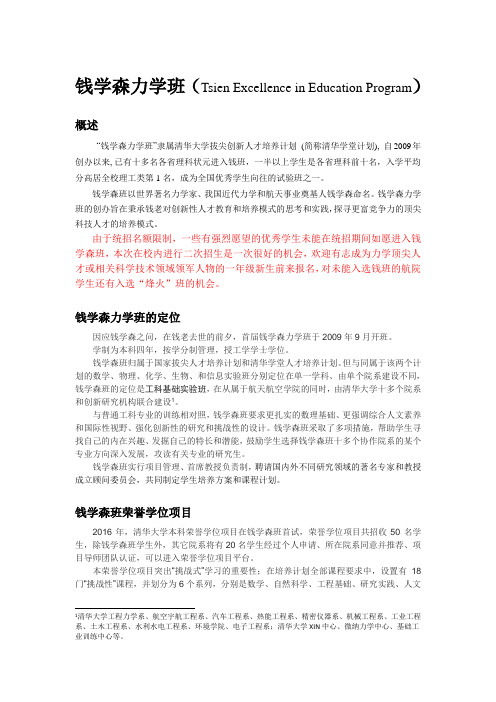
钱学森力学班(Tsien Excellence in Education Program)概述“钱学森力学班”隶属清华大学拔尖创新人才培养计划(简称清华学堂计划), 自2009年创办以来, 已有十多名各省理科状元进入钱班,一半以上学生是各省理科前十名,入学平均分高居全校理工类第1名,成为全国优秀学生向往的试验班之一。
钱学森班以世界著名力学家、我国近代力学和航天事业奠基人钱学森命名。
钱学森力学班的创办旨在秉承钱老对创新性人才教育和培养模式的思考和实践,探寻更富竞争力的顶尖科技人才的培养模式。
由于统招名额限制,一些有强烈愿望的优秀学生未能在统招期间如愿进入钱学森班,本次在校内进行二次招生是一次很好的机会,欢迎有志成为力学顶尖人才或相关科学技术领域领军人物的一年级新生前来报名,对未能入选钱班的航院学生还有入选“烽火”班的机会。
钱学森力学班的定位因应钱学森之问,在钱老去世的前夕,首届钱学森力学班于2009年9月开班。
学制为本科四年,按学分制管理,授工学学士学位。
钱学森班归属于国家拔尖人才培养计划和清华学堂人才培养计划。
但与同属于该两个计划的数学、物理、化学、生物、和信息实验班分别定位在单一学科、由单个院系建设不同,钱学森班的定位是工科基础实验班,在从属于航天航空学院的同时,由清华大学十多个院系和创新研究机构联合建设1。
与普通工科专业的训练相对照,钱学森班要求更扎实的数理基础、更强调综合人文素养和国际性视野、强化创新性的研究和挑战性的设计。
钱学森班采取了多项措施,帮助学生寻找自己的内在兴趣、发掘自己的特长和潜能,鼓励学生选择钱学森班十多个协作院系的某个专业方向深入发展,攻读有关专业的研究生。
钱学森班实行项目管理、首席教授负责制,聘请国内外不同研究领域的著名专家和教授成立顾问委员会,共同制定学生培养方案和课程计划。
钱学森班荣誉学位项目2016年,清华大学本科荣誉学位项目在钱学森班首试,荣誉学位项目共招收50名学生,除钱学森班学生外,其它院系将有20名学生经过个人申请、所在院系同意并推荐、项目导师团队认证,可以进入荣誉学位项目平台。
全国名校简介
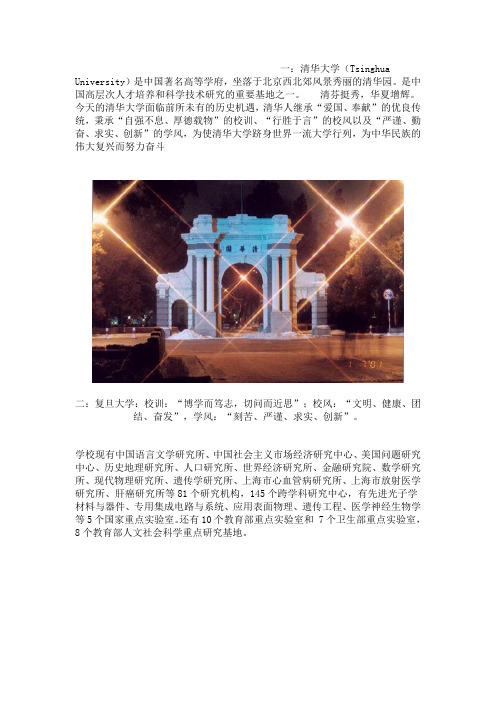
一:清华大学(Tsinghua University)是中国著名高等学府,坐落于北京西北郊风景秀丽的清华园。
是中国高层次人才培养和科学技术研究的重要基地之一。
清芬挺秀,华夏增辉。
今天的清华大学面临前所未有的历史机遇,清华人继承“爱国、奉献”的优良传统,秉承“自强不息、厚德载物”的校训、“行胜于言”的校风以及“严谨、勤奋、求实、创新”的学风,为使清华大学跻身世界一流大学行列,为中华民族的伟大复兴而努力奋斗二:复旦大学:校训:“博学而笃志,切问而近思”;校风:“文明、健康、团结、奋发”,学风:“刻苦、严谨、求实、创新”。
学校现有中国语言文学研究所、中国社会主义市场经济研究中心、美国问题研究中心、历史地理研究所、人口研究所、世界经济研究所、金融研究院、数学研究所、现代物理研究所、遗传学研究所、上海市心血管病研究所、上海市放射医学研究所、肝癌研究所等81个研究机构,145个跨学科研究中心,有先进光子学材料与器件、专用集成电路与系统、应用表面物理、遗传工程、医学神经生物学等5个国家重点实验室。
还有10个教育部重点实验室和 7个卫生部重点实验室,8个教育部人文社会科学重点研究基地。
三:武汉大学武汉大学是国家教育部直属重点综合性大学,是国家“985工程”和“211工程”重点建设高校。
令人瞩目的高水平办学成就,为武汉大学赢得了广泛的国际声誉,国际交流与合作日益频繁,学校与36个国家和地区的293所大学、科研机构建立了合作关系。
传承百年辉煌,尽展名校风采。
面对新的发展机遇和挑战,武汉大学以科学发展观为指导,制定了建设成为国内外知名高水平大学的总目标,明确了建设综合性、研究型、国际化大学的发展定位,致力于推动学者、学科、学术、学风、学生的协调发展,不断提高学校综合实力和核心竞争力,各项工作在稳定中发展,在创新中前进,学校整体呈现出快速发展的崭新局面。
四:浙江大学:浙大文化,经百年沉淀,十数辈传承,底蕴深厚,而今又站在时代前沿,浙大的校园文化,深受其益。
关于清华大学的简介-清华大学介绍
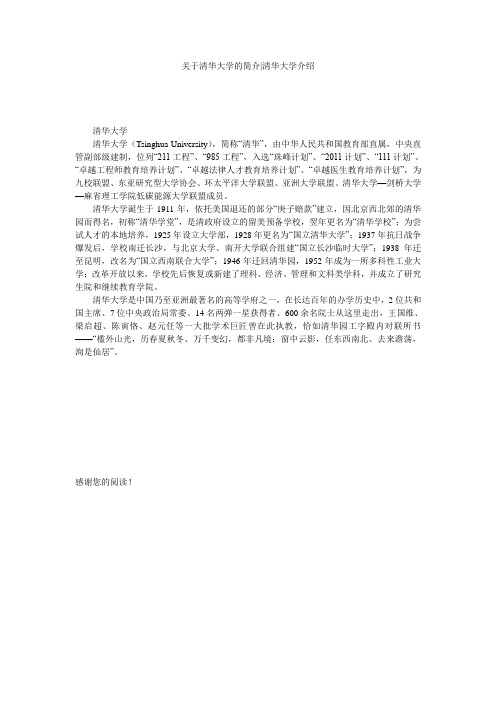
关于清华大学的简介|清华大学介绍
清华大学
清华大学(Tsinghua University),简称“清华”,由中华人民共和国教育部直属,中央直管副部级建制,位列“211工程”、“985工程”,入选“珠峰计划”、“2011计划”、“111计划”、“卓越工程师教育培养计划”、“卓越法律人才教育培养计划”、“卓越医生教育培养计划”,为九校联盟、东亚研究型大学协会、环太平洋大学联盟、亚洲大学联盟、清华大学—剑桥大学—麻省理工学院低碳能源大学联盟成员。
清华大学诞生于1911年,依托美国退还的部分“庚子赔款”建立,因北京西北郊的清华园而得名,初称“清华学堂”,是清政府设立的留美预备学校,翌年更名为“清华学校”;为尝试人才的本地培养,1925年设立大学部,1928年更名为“国立清华大学”;1937年抗日战争爆发后,学校南迁长沙,与北京大学、南开大学联合组建“国立长沙临时大学”;1938年迁至昆明,改名为“国立西南联合大学”;1946年迁回清华园,1952年成为一所多科性工业大学;改革开放以来,学校先后恢复或新建了理科、经济、管理和文科类学科,并成立了研究生院和继续教育学院。
清华大学是中国乃至亚洲最著名的高等学府之一,在长达百年的办学历史中,2位共和国主席、7位中央政治局常委、14名两弹一星获得者、600余名院士从这里走出,王国维、梁启超、陈寅恪、赵元任等一大批学术巨匠曾在此执教,恰如清华园工字殿内对联所书——“槛外山光,历春夏秋冬、万千变幻,都非凡境;窗中云影,任东西南北、去来澹荡,洵是仙居”。
感谢您的阅读!。
著名大学图片PPT

中央美术学院是教育部 直属的唯一一所高等美术学 校,于1950年4月由国立北 平艺术专科学校与华北大学 三部美术系合并成立,由毛 泽东为学院题名。学院现设 有造型学院、中国画学院、 设计学院、建筑学院、人文 学院、城市设计学院六个专 业学院,并设有继续教育学 院和附属中等美术学校。学 院以其高度的历史责任感, 思考中国美术发展的全局, 把握和引领中国美术教育的 教学实践和学术建构,引导 中国美术教育的进程,成为 中国美术院校的代表。
猜猜这是哪所大学?
哈佛大学是美国最 早的私立大学之一, 是以培养研究生和 从事科学研究为主 的综合性大学,哈 佛大学是全美第一 所大学,美国独立 战争以来大量的革 命先驱都出自于哈 佛的门下。哈佛大 学被誉为美国政府 的思想库。这里先 后诞生了八位美国 总统,40位诺贝尔 奖得主和30位普利 策奖得主。这里也 培养了缔造了微软、 IBM、Facebook等 一个个niversity of Cambridge)位于英 格兰的剑桥镇,是英国 也是全世界最顶尖的大 学之一。英国许多著名 的科学家、作家、政治 家都来自于这所大学。 剑桥大学也是诞生最多 诺贝尔奖得主的高等学 府,88名诺贝尔奖获得 者曾经在此执教或学习, 70多人是剑桥大学的学 生。剑桥大学和牛津大 学(University of Oxford)齐名为英国的 两所最优秀的大学,被 合称为“Oxbridge”剑 桥大学还是英国的名校 联盟“罗素集团” (Russell Group of Universities)和欧洲的 大学联盟科英布拉集团 (Coimbra Group)的 成员。
湖南大学是历史悠久、 声誉斐然的著名大学, 现为教育部直属全国 重点大学,国家“211 工程”、“985工程” 重点建设高校。学校 起源于中国古代四大 书院之一、创建于公 元976年的岳麓书院。 历经宋、元、明、清 等时势变迁,始终保 持着文化教育的连续 性,历时千年、弦歌 不绝。1903年书院改 制为湖南高等学堂, 1926年正式定名湖南 大学。先后经湖南高 等学堂、省立湖南大 学、国立湖南大学、 湖南大学、中南土木 建筑学院等时期,沧 桑砺洗、春华秋实。 深刻反映了中国教育 制度的变迁,成为中 国高等教育发展史的 一个缩影。被誉为 “千年学府,百年名 校”。
关于清华大学的简介:清华大学介绍
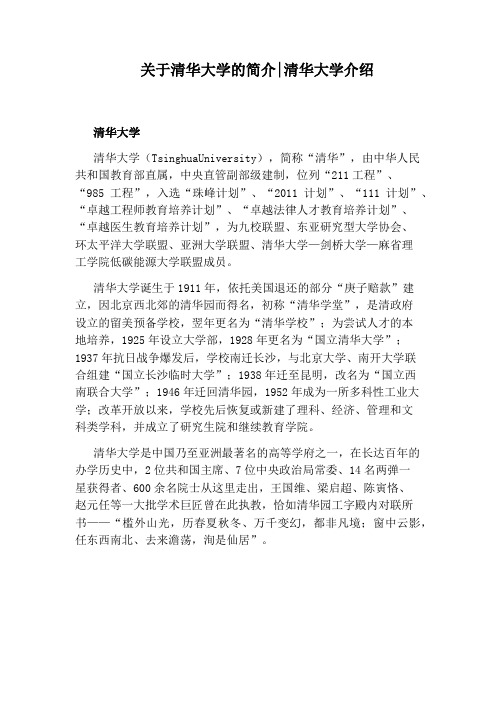
关于清华大学的简介|清华大学介绍
清华大学
清华大学(TsinghuaUniversity),简称“清华”,由中华人民共和国教育部直属,中央直管副部级建制,位列“211工程”、“985工程”,入选“珠峰计划”、“2011计划”、“111计划”、“卓越工程师教育培养计划”、“卓越法律人才教育培养计划”、“卓越医生教育培养计划”,为九校联盟、东亚研究型大学协会、
环太平洋大学联盟、亚洲大学联盟、清华大学—剑桥大学—麻省理
工学院低碳能源大学联盟成员。
清华大学诞生于1911年,依托美国退还的部分“庚子赔款”建立,因北京西北郊的清华园而得名,初称“清华学堂”,是清政府
设立的留美预备学校,翌年更名为“清华学校”;为尝试人才的本
地培养,1925年设立大学部,1928年更名为“国立清华大学”;1937年抗日战争爆发后,学校南迁长沙,与北京大学、南开大学联
合组建“国立长沙临时大学”;1938年迁至昆明,改名为“国立西
南联合大学”;1946年迁回清华园,1952年成为一所多科性工业大学;改革开放以来,学校先后恢复或新建了理科、经济、管理和文
科类学科,并成立了研究生院和继续教育学院。
清华大学是中国乃至亚洲最著名的高等学府之一,在长达百年的办学历史中,2位共和国主席、7位中央政治局常委、14名两弹一
星获得者、600余名院士从这里走出,王国维、梁启超、陈寅恪、
赵元任等一大批学术巨匠曾在此执教,恰如清华园工字殿内对联所书——“槛外山光,历春夏秋冬、万千变幻,都非凡境;窗中云影,任东西南北、去来澹荡,洵是仙居”。
中国名牌大学

中国名牌大学清华大学清华大学(英文名:Tsinghua University),简称"清华",地处北京西北郊繁盛的园林区,是在几处清代皇家园林的遗址上发展而成的。
清华大学的前身是清华学堂,始建于1911年,曾是由美国退还的部分庚子赔款建立的留美预备学校。
1912年,清华学堂更名为清华学校。
1925年设立大学部,开始招收四年制大学生。
1928年更名为国立清华大学,并于1929年秋开办研究院。
目前,清华大学设有16个学院,56个系,已成为一所具有理学、工学、文学、艺术学、历史学、哲学、经济学、管理学、法学、教育学和医学等学科的综合性、研究型、开放式大学。
清华大学是中国大陆地区的著名高校,工学、管理学、理学、经济学、传播学、法学、医学、哲学、文学、艺术学、历史学等都是它的强项。
清华是中国政府重点支持建设的两所大学之一,国家首批“211工程”和“985工程”系列的重点大学,是九校联盟(C9)的成员。
清华是亚洲和世界最重要的大学之一。
清华是中国大陆高考竞争最激烈的大学之一,每年只有中国各省市高考成绩最优秀的高中毕业生才有机会被清华录取。
清华大学的本科生,毕业后一部分到美国的院校攻读博士学位。
据《高教年鉴》报道,2006年清华是获得美国院校博士学位最多的本科生生源院校榜首。
校容校貌校园内绿草青青,树木成荫,湖光山色,景色优雅,各个不同时期的建筑自然形成各具风格的建筑群落,为师生创造了适宜的工作、学习、生活环境。
清华园大礼堂的草坪前日晷上在风雨中挺立数十载,上面刻着清华的校风:“行胜于言”。
“行胜于言”不是不言,而是言必求实,以行证言。
清华大学在四川地区文科录取分数线北京大学北京大学(英文名:Peking University),简称“北大”。
初名京师大学堂,是中国近代第一所国立大学,以最高学府身份创立,最初也是当时中国最高教育行政机关,行使国家教育部职能。
北京大学“上承太学正统,下立大学祖庭”,在中国高等教育史上具有承上启下的独特地位。
清华大学 Tsinghua University
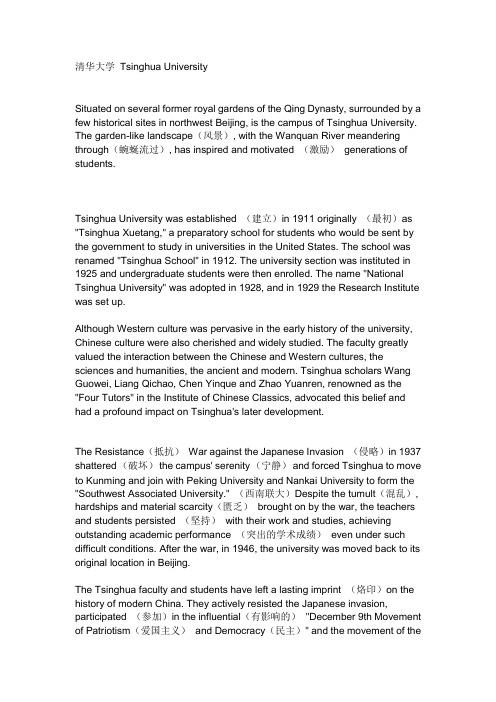
清华大学Tsinghua UniversitySituated on several former royal gardens of the Qing Dynasty, surrounded by a few historical sites in northwest Beijing, is the campus of Tsinghua University. The garden-like landscape(风景), with the Wanquan River meandering through(蜿蜒流过), has inspired and motivated (激励)generations of students.Tsinghua University was established (建立)in 1911 originally (最初)as "Tsinghua Xuetang," a preparatory school for students who would be sent by the government to study in universities in the United States. The school was renamed "Tsinghua School" in 1912. The university section was instituted in 1925 and undergraduate students were then enrolled. The name "National Tsinghua University" was adopted in 1928, and in 1929 the Research Institute was set up.Although Western culture was pervasive in the early history of the university, Chinese culture were also cherished and widely studied. The faculty greatly valued the interaction between the Chinese and Western cultures, the sciences and humanities, the ancient and modern. Tsinghua scholars Wang Guowei, Liang Qichao, Chen Yinque and Zhao Yuanren, renowned as the "Four Tutors" in the Institute of Chinese Classics, advocated this belief and had a profound impact on Tsinghua's later development.The Resistance(抵抗)War against the Japanese Invasion (侵略)in 1937 shattered (破坏)the campus' serenity (宁静)and forced Tsinghua to move to Kunming and join with Peking University and Nankai University to form the "Southwest Associated University." (西南联大)Despite the tumult(混乱), hardships and material scarcity(匮乏)brought on by the war, the teachers and students persisted (坚持)with their work and studies, achieving outstanding academic performance (突出的学术成绩)even under such difficult conditions. After the war, in 1946, the university was moved back to its original location in Beijing.The Tsinghua faculty and students have left a lasting imprint (烙印)on the history of modern China. They actively resisted the Japanese invasion, participated (参加)in the influential(有影响的)"December 9th Movement of Patriotism(爱国主义)and Democracy(民主)" and the movement of the"Struggle against Starvation, Civil War and Persecution (迫害)," and devoted themselves to the pursuit(追求)and spread of the truth that would give new birth to the nation in the midst of her struggle for independence.After the founding of the People's Republic of China, the university was molded(改造)into a polytechnic institution (工学院)focusing on engineering in the nationwide restructuring(重新调整)of universities and colleges undertaken in 1952. In November 1952, Jiang Nanxiang became the president of the university. He sought to best way to promote Chinese higher education and made significant contributions in redirecting Tsinghua to become the national center for training engineers and scientists with both professional proficiency(精通)and personal integrity(健全的人格).Tsinghua has flourished (繁荣)since 1978, with the re-establishment of the departments in sciences, economics and management, and the humanities(人文科学). The Tsinghua graduate school has been recognized nationally, ranking first in the National Evaluation (评估)of Graduate Schools. The School of Continuing Education makes the best use of modern information technologies, as well as the advanced educational resources at Tsinghua. Currently, the university consists of 44 departments distributed (分布)in 11 schools(学院), including the schools of sciences, architecture, civil engineering, mechanical engineering, information science and technology, humanities and social sciences, economics and management, law, arts and design, public policy and management, and applied technology. A medical school is currently being established. Tsinghua is developing into a comprehensive university (综合大学)at a breathtaking(惊人的)pace.With a splendid legacy (传统)accumulated (积淀)over the past 90 years, Tsinghua has retained (保留、保持)its character and charm while promoting rigorous scholarship(严谨的治学态度)research, ensuring(保证)academic and educational prestige(声誉)in China and abroad. The university currently has over 7,100 faculty and staff, with over 900 full professors(正教授)and 1,200 associate professors(副教授), including 24 members of the Chinese Academy of Sciences and 24 members of the Chinese Academy of Engineering.The educational philosophy(教育理念)of Tsinghua is to "train students with integrity." Among the over 100,000 students who have graduated from Tsinghua since its founding are many outstanding scholars, eminent (杰出的)entrepreneurs(企业家)and great statesmen remembered and respected by their fellow Chinese citizens. Hence(因此), to study at Tsinghua is the dream of many Chinese youth. Presently, Tsinghua has over 20,000 students, including 12,000 undergraduates(本科生), 6,200 master's degrees candidates (硕士研究生)and 2,800 doctoral candidates(博士研究生).With strong support from the nation and in the face of unprecedented (崭新的)opportunities, Tsinghua University is poised (准备)to become aworld-class university in the 21st century. With the inspiring motto"Self-discipline and Social Commitment," Tsinghua is dedicated (贡献)to the well being (福祉)of Chinese society.北京大学Peking UniversityPeking University is a comprehensive(综合性)and National key university. The campus, known as "Yan Yuan"-- the gardens of Yan, is situated at the northeast of the Haidian District at the western suburbs of Beijing. It stands near the Yuan Ming Gardens and the Summer Palace.The University consists of 30 colleges and 12 departments, with 93 specialties (专业)for undergraduates,2 specialties for the second Bachelor's degree(学士学位), 199 specialties for Master candidates and 173 specialties for Doctoral candidates. While still laying stress(重点在于)on basic sciences, the university has paid special attention to the development of applied sciences(应用科学).At present, Peking university has 216 research institutes and research centres, and there are 2 national engineering research centres, 81 key national disciplines(学科), 12 national key laboratories.The university has made an effective combination of the research on important scientific issues with the training of personnel with high level specializedknowledge and professional skill as demanded by the country's socialist modernization. It strives (努力、奋斗)not only for the simultaneous(同步)improvements in teaching and research work, but also for the promotion(促进)of interaction and mutual(相互的)promotion among various subjects.Thus Peking University has become a center for teaching and research and a university of the new type, consisting of diverse branches of learning such as pure and applied sciences, social sciences and the humanities, and sciences of management and education. Its aim is to rank among the world's best universities at the beginning of the next century.浙江大学Zhejiang UniversityIn September 1998, a new Zhejiang University was established on the basis of the amalgamation(合并)of the four former individual universities, namely Zhejiang University, Hangzhou University, Zhejiang Agricultural University and Zhejiang Medical University, which were all located in the garden city of Hangzhou. Approved (同意)by the State Council(国务院), the founding of the new Zhejiang University has been a significant move in the reform and development of China's higher education. The four universities have grown out of the same ancestry, the Qiushi (with the literal meaning of "seeking truth" in Chinese) Academy, which was founded a century ago as one of the earliest institutions of higher learning in China. As a result, they have all inherited from it the spirit of "Qiushi" and at the same time, built up their own distinctive features(特点)in teaching and research.Under the direct administration(管理)of China's Ministry of Education, the new Zhejiang University is a key comprehensive university whose fields of study cover eleven branches of learning, namely philosophy, literature, history, education, science, economics, law, management, engineering, agriculture and medicine. The university, now has 115 specialties(专业)for undergraduate studies, and it is entitled (有资格)to confer(授予)mastersdegrees in 312 programs and doctoral degrees in 237 programs. Under its administration there are 13 Nation Key Laboratories, 2 National Engineering Research Centers and 3 National Engineering Technology Centers. Besides, it has set up 24 nation key specialties and 39 post-doctor stations.Endowed(赋予)with a pleasant climate, picturesque(风景如画)surroundings and a favorable academic atmosphere(良好的学术氛围), Zhejiang University is an ideal place for teaching, research, and learning. With six campuses, namely Yuquan, Xixi, Huajiachi, Hubin, Zhijiang, and Zijingang, the university now occupies a total area of 533 hectares and a floor space of over 2,000,000 square meters. At present, the total number of full time students has reached over 40,000, including more than 23,600 undergraduates, over 9,300 postgraduates working for master's degrees and over 6,200 Ph.D. candidates. There are also nearly 37,000 students taking courses in degree and non-degree programs in adult education. Among its 8,400 staff members and workers, there are 14 members of the Chinese Academy of Sciences, 9 members of the Chinese Academy of Engineering, over 1,200 full professors and over 2,400 associate professors. With a total space of 83,000 square meters, the university library has a collection of more than 6,390,000 volumes. In addition, the university has 6 affiliated hospitals(附属医院), providing medical services of various kinds for people from all over Zhejiang province.At the turn of the century, the university is taking full advantage of the opportunities brought by the amalgamation, and will continue to give priority to education and research. It seeks to offer service to the nation's economic development, and to make every effort to build itself into an institution on a par with the first-class university in the world.南京大学Nanjing UniversityNanjing University is one of China's key comprehensive universities and it functions directly under the Ministry of Education. It is located in the ancient capital of six dynasties -- Nanjing. The University dates back to 1902 whenSanjiang Normal School was founded, and then evolved as Liangjiang Normal School, Nanjing Higher Normal School, National Southeast University, the Fourth Zhongshan University, and National Central University. On August 8, 1949, the National Central University was renamed National Nanjing University. In October 1950, as required by the Ministry of Education, the name was changed to Nanjing University. In 1952, when a nationwide readjustment of universities took place, some schools, such as the School of Engineering and the School of Agriculture, were separated from the University; meanwhile, the University merged with the School of Liberal Arts and the School of Sciences of the University of Nanking, which was founded in 1888. The new university remained Nanjing University and the campus of Nanjing University moved from Sipailou to Gulou.Today, Nanjing University consists of two campuses, one in Gulou and the other in Pukou with a total area of more than 3,600 mu (nearly 600 acres). It is one of the top universities in China, with beautiful campuses and modern teaching and research facilities. Its current President is Professor Chen Jun, a geochemist. The University celebrates its anniversary on May 20 of each year.Nanjing University's development has always been closely bound with the destiny of the Chinese nation and linked to her ever changing society. Nanjing Higher Normal University, the predecessor of Nanjing University, played a leading role in the area of Nanjing when the Youth Democratic Movement was held on May 4, 1919. In the early 1920s, it was in this university that a group of Chinese communist forerunners introduced the theory of Marxism to the public. The Second National Conference of Chinese Communist Youth League was also held at the University. During the Anti-Japanese War, organizations like the "Natural Sciences Forum" and the "Democracy and Science Forum", headed by Pan Shu, Liang Xi and Jin Baoshan, renowned professors of National Central University, eventually became the democratic party "Jiu San Society." During the Liberation War, teachers and students of National Central University stood at the forefront through out the democratic patriotic movement. On May 20, 1947, students of National Central University initiated an "Anti-Hunger, Anti-Civil War and Anti-Persecution Movement", later known as the "May 20th Patriotic Students Movement." After the National Central University was renamed Nanjing University, the truth-seeking convention was carried forward. In May 1978, one scholar at the Philosophy Department published, in the Guangming Daily, a well-known essay entitled "Practice Is the Sole Criterion for Testing Truth" and thus evoked "a heated discussion on the criterion of truth" that attracted nationwide attention.。
清华大学介绍中英文互译介绍
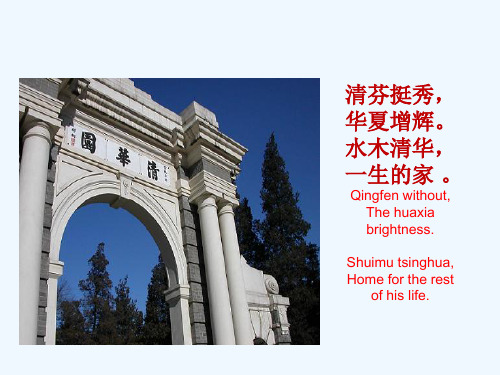
Do a man of noble, in such aspects as moral integrity, integrity, character, research should be indomitable, defeat oneself, forever upward, strive to be career and conduct both reached the highest realm. In terms of we should comply with the nature, the mind, forgive, to undertake the historical mission of grand
水木清华Shuimu tsinghua
清华大学的前身是清华学堂,始建于1911年,当时是由美国
“退还”的部分“庚子赔款”建立的留美预备学校。1912年,清华学 堂更名为清华学校。以清华国学研究院四大导师王国维、梁启超、陈 寅恪、赵元任以及李济等为代表的清华学者,主张“中西兼容、文理 渗透、古今贯通”,形成了著名的“清华学派”,对清华的发展产生 了深远的影响,培养出了一大批高水平的学术大师。 Predecessor is tsinghua school of tsinghua university, founded in 1911, was part of the "refund" by the United States was "boxer indemnity" eshe United States.
Shuimu tsinghua水木清华
建筑学院School of architecture
清华大学简介英文版(History of Tsinghua)
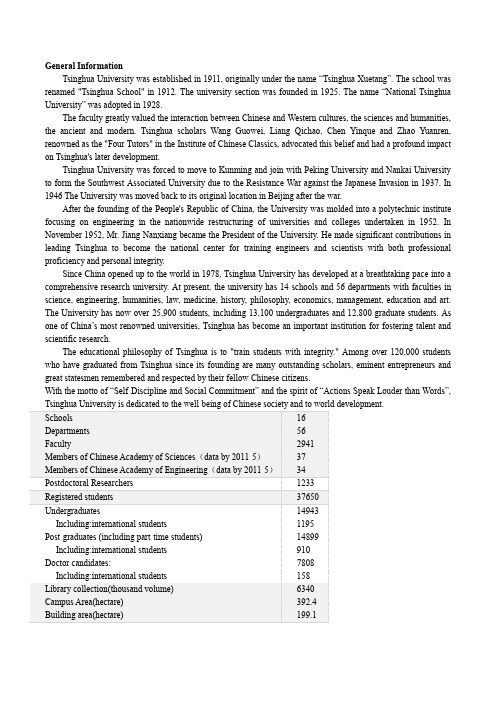
General InformationTsinghua University was established in 1911, originally under the name “Tsinghua Xuetang”. The school was renamed "Tsinghua School" in 1912. The university section was founded in 1925. The name “National Tsinghua University” was adopted in 1928.The faculty greatly valued the interaction between Chinese and Western cultures, the sciences and humanities, the ancient and modern. Tsinghua scholars Wang Guowei, Liang Qichao, Chen Yinque and Zhao Yuanren, renowned as the "Four Tutors" in the Institute of Chinese Classics, advocated this belief and had a profound impact on Tsinghua's later development.Tsinghua University was forced to move to Kunming and join with Peking University and Nankai University to form the Southwest Associated University due to the Resistance War against the Japanese Invasion in 1937. In 1946 The University was moved back to its original location in Beijing after the war.After the founding of the People's Republic of China, the University was molded into a polytechnic institute focusing on engineering in the nationwide restructuring of universities and colleges undertaken in 1952. In November 1952, Mr. Jiang Nanxiang became the President of the University. He made significant contributions in leading Tsinghua to become the national center for training engineers and scientists with both professional proficiency and personal integrity.Since China opened up to the world in 1978, Tsinghua University has developed at a breathtaking pace into a comprehensive research university. At present, the university has 14 schools and 56 departments with faculties in science, engineering, humanities, law, medicine, history, philosophy, economics, management, education and art. The University has now over 25,900 students, including 13,100 undergraduates and 12,800 graduate students. As one of China’s most renowned universities, Tsinghua has become an important institution for fostering talent and scientific research.The educational philosophy of Tsinghua is to "train students with integrity." Among over 120,000 students who have graduated from Tsinghua since its founding are many outstanding scholars, eminent entrepreneurs and great statesmen remembered and respected by their fellow Chinese citizens.With the motto of “Self-Discipline and Social Commitment” and the spirit of “Actions Speak Louder than Words”,History of TsinghuaLocated in the northwestern suburbs of Beijing, Tsinghua University wasestablished in 1911 on the site of “Qing Hua Yuan (Tsinghua Garden)” —a formerroyal garden of the Qing Dynasty. Partly funded by the “Gengzi Indemnity”, alsoknown as “Boxer Indemnity,” it functioned at first as a preparatory school called“Tsinghua Xuetang (Tsing Hua Imperial College)” for those students who weresent by the government to study in the United States.On April 29, 1911, Tsinghua Xuetang began its first term of study, and from thatyear on, the Tsinghua’s anniversary has fallen on the last Sunday of April. Thename was changed to “Tsinghua Xuexiao (Tsing Hua College)” after the 1911Revolution.In 1925, Tsinghua launched its four-year undergraduate programme. In 1928,its name was changed to “Guoli Tsinghua Daxue (National Tsinghua University),”and in the autumn of 1929 its graduate school was set up.Following the outbreak of the War of Resistance against Japan in 1937, Tsinghua University, Peking University and Nankai University merged to form the National Southwest Associated University in Kunming. After the war, Tsinghua University moved back to its original Beijing campus.Three years after the founding of the People’s Republic of China, a nationwide restructuring of institutes of higher education began, and in 1952, Tsinghua University became a multidisciplinary polytechnic university specializing in training engineers. In November of that year, the Ministry of Education appointed Jiang Nanxiang as President.Since 1978, Tsinghua University has strengthened its teaching in sciences, economic management, humanities and law. In 1999, Tsinghua opened the School of Arts and Design by merging with the Central Academy of Arts and Design. Today, Tsinghua has become a leading university: while its teaching is focused on engineering, it concurrently offers degrees in other sciences, the liberal arts, management and law.To fully implement the “China Education Reform and Development Program,” Tsinghua University has set new development targets for the next 15 years. Educational quality and effectiveness will be improved and disciplinary structure will be readjusted. Building on our strength in engineering, the university will promote the development of science and management departments. High academic standards will also be pursued in the humanities and social sciences.In less than 100 years, Tsinghua University has witnessed and shared the hardships and glories of the nation. The University’s motto of “Self-discipline and Social Commitment” has inspired many generations of Tsinghua teachers and students to struggle for the prosperity of China. Now, striving to build Tsinghua University into a world-class university by its 100th anniversary in 2011 has become the objective of each member of the teaching staff and the student body.Tsinghua Garden(清华园-工字厅)Tsinghua Garden is architecturally unique. It preserves original architectural features over three centuries old. The garden retains a traditional Qing private garden design and style with painted corridors connecting every room. It has functioned as the university's head office for many years. Due to its distinctive characteristics, it has become a major attraction on campus.The more popular name of the garden is Gong Zi Ting -- which in Chinese means H-Shaped House. Viewed from above, the central part of the house resembles the letter "H", with its two halls in the front and back connected by a short corridor in the middle.The garden started out as the residence of a Qing emperor’s brother’s family. In the early days of Tsinghua School, founded in 1911, the garden was used as the school’s first head office building. Student enrollment lists were posted on the wall at the front gate. For some years in its history, the east room in the front section was used as the Music Center, the west room as the teacher’s reading room and the back section to accommodate distinguished foreign guests. The great Indian poet Rabindranath Tagore stayed there when he visited China in 1924.Auditorium(大礼堂)Located at the heart of the oldest area on Tsinghua campus is the imposing auditorium. Mixing Greek and Roman architectural styles, the 1,200-seat auditorium has a rounded roof, a brass gate, and four large white marble columns. It possesses few design embellishments; its magnificence is evident in its simplicity.Construction on what is now one of the favorite buildings on campus began in September 1917 and concluded in March 1920. The auditorium was one of the four major building projects carried out by Tsinghua School, together with Tsinghua Xuetang, the old library, and the gymnasium.In its day, it was the largest auditorium of its kind at a university in China, and could seat the entire faculty, staff and student body for school assemblies.Tsinghua School(清华学堂)Tsinghua School, a two floor German style building, was one of the main buildings of the school at it’s early stage. It was a student dormitory building.The west wing was built during 1909-1911. The east wing was built in 1916. The total construction area was 4650 m².The four Chinese characters painted above the main entrance read “Tsinghua School”, the first name of the institution when it was founded. The inscription was by Na Tong, a Great Scholar and Grand Minister in late Qing Dynasty.In the last few decades, it was used as teaching building and classrooms. Now it is the offices of some main administration departments: the Graduate School, the undergraduate academic department and the R&D department.The Old Gate(二校门)The Old Gate was built in 1909. In May of that year, the Qing dynasty government approved the application from the Department of Foreign Affairs to establish a school in the suburbs of Beijing. Tsinghua Garden was chosen as the site for the school. The Gate was the main entrance to the school campus at that time.At that time, the Gate was not only stately and graceful, but also heavily guarded. In those years, underclassmen were not allowed to go beyond the gate without permission from school authorities. In addition, for the sake of preserving the sanctity of the learning environment, people not on official school business were forbidden to pass through the gate.In 1933, after the expansion of the residential area, the former enclosing wall was moved to further out. A new gate, now Tsinghua's West Gate, became the new main entrance. Ever since, the original gate has been called Er Xiao Men (means "the second school gate").The Old Gate was demolished in 1960’s. Donated by Tsinghua University Alumni, it was rebuilt in 1991, following the original design.Shui Mu Tsinghua(水木清华)Shui Mu Tsinghua, which means "clear water and trees surrounding Tsinghua," is one of the most captivating spots in Tsinghua Yuan. Located near the rear gate of the H-shaped Hall, Shui Mu Tsinghua is often compared by Tsinghua students to the Garden of Harmonious Interests in Beijing's famed Summer Palace. It is a "garden within a garden."Shui Mu Tsinghua has many charms. Unusual rock formations abound, and a variety of trees, which change color from season to season, encircle an expanse of calm, clear water. On the northern bank are two ancient, graceful pavilions. The four Chinese characters "Shui Mu Tsing Hua" painted on the top of the main gate, were copied from an inscription by Emperor Kang Xi.The Main Building(主楼)The Main Building, located in the eastern area of campus, is composed of three sections covering a total area of 76,871 square meters. It was jointly designed by the Tsinghua students and teachers from different departments after the liberation of China.For more than 30 years since it was set up, the Main Building held many departments, including those of Architecture, Automation, Computer Science, Mathematics, and Foreign Languages, making significant contributions to both teaching and scientific research.Today, the central and east sections are the home of the departments of Automation, Computer Science and Technology, and Electronic Engineering. The west section mainly houses the department of Electrical Engineering and Applied Electrical Technology.School of Science(科学馆)The building that houses the School of Science was built and put into use just before Tsinghua's 50th anniversary in 1961. It was designed in the Western Classical style by professors from the School of Architecture and Guan Zhaoye, a member of the Chinese Academy of Engineering.The School of Science has a long and brilliant history. It was established in 1929. The first president was renowned physicist Ye Qisun, one of the founders of modern science education in China. Since it opened, it has produced a number of outstanding scholars. By the end of 1940, the department of Physics alone had produced many academicians for the Chinese Academy of Science, including Wang Jinchang, Zhou Tongqing, Gong Zutong, Zhao Jiuzhang, Fu Chengyi, Wang Zhuxi, Weng Wenbo, Zhang Zongsui, Qian Weichang, Peng Huanwu, Qian Sanqiang, He Zehui, Wang Daheng, Yu Zhongzheng, Ge Tingsui, Qin Xinling, Lin Jiaqiao, Zhang Enqiu, Hu Ning, Chen Fangyun, Li Zhengwu, and Lu Xueshan.Graduating from other departments were noted scholars Xu Baolu, Ke Zhao, Duan Xuefu, Chen Xingshen, Yuan Hanqing, Hua Luogeng, Zhang Dayi, Wang Dexi, Cao Benxi, Zhang Qinglian, Feng Xinde, Chen Xinmin, Huang Peiyun, Sun Dehe, Zhu Yajie, Shen Panwen, Tang Aoqing, Yan Dongsheng, Xiao Lun, Shi Jun, Chen Guanrong, Wu Chi, Gao Zhenheng, Wang Shizhen, Wang Fuxiong, Wu Zhengyi, Wang Zhijun, Lou Chenghou,Xu Ren, Huang Shaoxian, Cheng Chunshu, Xie Yibing, Wang Hongzhen, Cheng Yuqi, Dong Shenbao, Wu Heng, Zhang Bingxi, Ye Duzheng, Guan Shicong, Yang Zunyi, Song Shuhe.Palace of the Ancient Moon(古月堂)Near the H-Shaped Hall, the Palace of the Ancient Moon stands alone as a secluded courtyard. Being 670 square meters large, it was constructed in the second year of Emperor Dao Guang's reign. Originally it was the private study chamber of the host. When the school was founded, it became a living quarters for the school staff, and noted scholars such as Prof. Liang Qichao and Prof. Zhu Ziqing also lived there. In 1928, it was designated as a dormitory for the school's first group of female students. Since the founding of the People's Republic of China, ithas housed the school's administrative offices.Gymnasium(西操)The gymnasium, distinguished for its historic and cultural value, has been one of the most beloved spots on campus for generations of Tsinghua graduates. It has been a gathering place for the most outstanding people in the field of physical education, bringing up thousands of talented athletes to represent China. Pioneers of physical education such as John Ma and Hao Gengshen taught there for decades.The gym was constructed in two stages. The front hall, with its Western Classic architectural style, was built from 1916 to1919. The back hall was built from 1931 to 1932, and followed the same design style.When it was founded, the gym was one of the most advanced of its kind in the country. It housed a basketball court, an suspension athletic track, and various kinds of athletic equipment. It now has an indoor swimming pool, which was used by former Chairman Mao Zedong after the liberation of China.DiningInternational students can apply for a Dining Card at the Food Service Center (Business hours: 8:00-13:00, 15:00-18:00) located in No.15 Building with their Admission Notice/Student ID Cards or certificates issued by FSAO. Students may have meals in any students’ dining hall with this card. A temporary card or cash is required at other dining places. Students are expected to maintain the order of the dining halls, help to keep the places clean and tidy, take care of the facilities and equipment, and show respect to the working staff.Campus ServicesService facilities inside Tsinghua University make the life of students very convenient. The on-campus shopping center is located at Zhaolanyuan, where one can find banks, post office, super-market, bookstores, fruit and vegetable market, photo studios, restaurants, the barber’s, laundries, etc. All kinds of services are also provided in the living area of students.Banking ServiceThe Industrial and Commercial Bank of China, China Construction Bank and Bank of Beijing in Zhaolanyuan shopping center, Bank of China in Zijing Student Service Center (Building C) provide service for deposit and exchange of foreign currencies. US dollar, Euro, Pound, Yen can be exchanged to Renminbi. But the traveler's check is not acceptable there. Large amount of foreign currencies and traveler's check can be exchanged to Renminbi at a branch of Bank of China located at Chuangxin Plaza nearby University's East Gate. Banks open from 9:00 to 17:00 everyday.On-campus Automated Teller Machines (ATMs) can be found at places like the Zijingyuan Dinning Hall, the Taoliyuan Dinning Hall, the Zijing Building No.4, 5 and 6, the post office, the Industrial and Commercial Bank of China, outside the Tingtaoyuan (formerly named No.10 Dining Hall), on the first floor of Guanchouyuan(formerly named Dining Plaza), the Financial Department of the University, etc.Mailing ServiceThe post office located in the Student Service Center located in the west of the Zijing dormitory and Zhaolanyuan opens from 8:30 to 17:30 everyday, providing services of mailing, sending and receiving parcels, fax, telegram, distance calls, etc.ShoppingThe shopping center of Tsinghua is located in Zhaolanyuan. Besides, several other supermarkets can be found, such as the Zijing Student Supermarket at the underground floor of the Student Service Center, Zijing Supermarketin the Dining Plaza, and the Student Supermarket between No.7 and No.8 student dormitories. Banks, shops and bookstores are installed at the Student Service Center.Sports FacilitiesThe on-campus sports facilities include the following.The indoor swimming and diving gymnasium, and the West Lake outdoor swimming pool (Open from June.1st to Sep 1st each year).The comprehensive gymnasium (sports facilities provided: badminton, table tennis, basketball, and gymnastic apparatus).Western gymnasium (sports facilities provided: badminton, basketball, and billiards).The plastic tennis court, the eastern gymnasium, and the table tennis Center.International students may use the above mentioned services with Student ID cards and pay relevant fees.Library Collections●General IntroductionTsinghua University Library's collection is emphasized on Science and Technology and also covers broad subjects of Humanities, Social Sciences and Management. The total collection amounts to more than 3.96 million items, including:Printed Collections•222,282 thread-bound ancient books;•More than 3,268 current serials and 585,976 bound periodicals;•More than 94,836 Tsinghua University dissertations and theses;•More than 20,000 microforms;•Other books.Electronic Resources•Near 57,000 full-text e-journals;•459electronic databases;•More than 2,383,000 e-books;•More than 45,000 multimedia collections.Tsinghua University Library was established in 1912, just one year after the “Tsinghua Xue Tang” was founded. Up to now, Tsinghua university library system includes the university library, 6 subject branch libraries and more than 10 school or department reading rooms. In the past few years the library has expanded its collection very fast especially in the e-resources. The total physical collections have been over4.0 million item/volumes, full-text e-journals in Chinese and foreign languages are over 57,000 and e-books are more than 2.39 million by end of 2010. In 1996, the Library introduced integrated library management system (INNOPAC) for cataloging and circulation management, which was the first one in China. In 2005, the library brought in MetaLib+SFX, the e-resources integration system, established Tsinghua Academic Information Resource Portal. Now the faculty and students of Tsinghua University are able to access the library's e-resources conveniently and safely at any time and from any places.AlumniTsinghua alumni have stepped all over the world and are active in the developed countries such as the United States and Japan, the developing ones including India and Thailand, and the distant southern Africa and South America as well. Around 20,000 alumni currently stay abroad, mostly in North America, and nearly half of them live and work in Silicon Valley under the background of the University’s strength in science and engineering. Nearly 50 Tsinghua alumni organizations have been established in over 10 countries.。
清华大学介绍
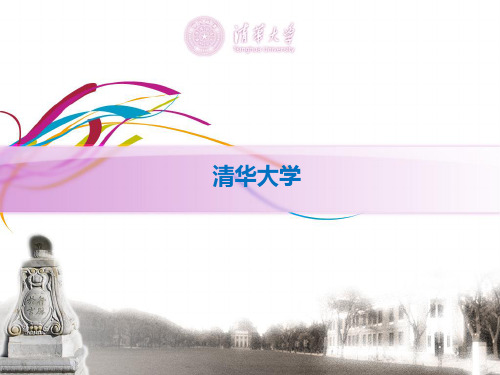
科学馆
科学馆位于大礼堂西南,与同方部遥 相对应,是清华早期四大建筑(大礼 堂、图书馆、科学馆、体育馆)之一 。科学馆始建于1917年4月,落成于 1919年9月。建馆之初,这里是学校 理科教学和实验的场所,从1926年物 理系建系,特别是1929年清华理学院 建院以后,直到 1999年新理学大楼建 成,科学馆一直被作为物理系馆。如 今,完好如初的科学馆已作为杨振宁 和林家翘两教授回国工作后创建的两 个研究中心(即高等研究中心)及周 培源应用数学研究中心的科研办公基 地,仍然屹立在校园中心大草坪西侧 。
理学院楼
理学院楼是理学院建筑群中的主体建筑,由我校建筑学院教授、中国工程院院士关肇 邺设计,国庆50周年前夕落成使用。它占地2.7万平方米,建筑面积超过1.5万平方米 ,是理学院建筑群中最大的一座楼。全楼整体采用西洋古典建筑形式,并具有现代化 气息,建筑周围有大片绿地,环境幽静,建筑典雅,是校园建筑的又一佳作。楼内共 设5个机构:理学院院部、物理系馆、数学系馆、高等研究中心和化学系分析中心实验 室。长期驻守在理学院楼里的理学院有着悠久的历史和光荣的业绩。清华大学理学院 创建于1929年,创始院长是我国现代科教事业创始人之一的杰出物理学家叶企孙先生 ,吴有训、熊庆来分别担任过院长或代理院长,80多年来,清华大学理学院培养出了 几十位两院院士和两位诺贝尔奖获得者,在国内有着较高的学术声望。
历任领导
梅贻琦 冯友兰
顾秉林 陈吉宁
胡和平
ቤተ መጻሕፍቲ ባይዱ
知名校友
(排名不分先后)
季羡林
钱学森
杨振林
邓稼先
梁实秋
在清华100多年的历史中,59位清华学子当选为解放前的中央研究院院士,500多位校 友(含协和)当选为中国科学院院士和中国工程院院士,17名校友当选美国国家院士。 约有1/4的中国科学院院士,1/5的中国工程院院士是清华校友,500多名毕业生就任国内 院校校长、党委书记,以上数据在国内均位列全国高校第一位
清华大学简介英文版(History of Tsinghua)

General InformationTsinghua University was established in 1911, originally under the name “Tsinghua Xuetang”. The school was renamed "Tsinghua School" in 1912. The university section was founded in 1925. The name “National Tsinghua University” was adopted in 1928.The faculty greatly valued the interaction between Chinese and Western cultures, the sciences and humanities, the ancient and modern. Tsinghua scholars Wang Guowei, Liang Qichao, Chen Yinque and Zhao Yuanren, renowned as the "Four Tutors" in the Institute of Chinese Classics, advocated this belief and had a profound impact on Tsinghua's later development.Tsinghua University was forced to move to Kunming and join with Peking University and Nankai University to form the Southwest Associated University due to the Resistance War against the Japanese Invasion in 1937. In 1946 The University was moved back to its original location in Beijing after the war.After the founding of the People's Republic of China, the University was molded into a polytechnic institute focusing on engineering in the nationwide restructuring of universities and colleges undertaken in 1952. In November 1952, Mr. Jiang Nanxiang became the President of the University. He made significant contributions in leading Tsinghua to become the national center for training engineers and scientists with both professional proficiency and personal integrity.Since China opened up to the world in 1978, Tsinghua University has developed at a breathtaking pace into a comprehensive research university. At present, the university has 14 schools and 56 departments with faculties in science, engineering, humanities, law, medicine, history, philosophy, economics, management, education and art. The University has now over 25,900 students, including 13,100 undergraduates and 12,800 graduate students. As one of China’s most renowned universities, Tsinghua has become an important institution for fostering talent and scientific research.The educational philosophy of Tsinghua is to "train students with integrity." Among over 120,000 students who have graduated from Tsinghua since its founding are many outstanding scholars, eminent entrepreneurs and great statesmen remembered and respected by their fellow Chinese citizens.With the motto of “Self-Discipline and Social Commitment” and the spirit of “Actions Speak Louder than Words”,History of TsinghuaLocated in the northwestern suburbs of Beijing, Tsinghua University wasestablished in 1911 on the site of “Qing Hua Yuan (Tsinghua Garden)” —a formerroyal garden of the Qing Dynasty. Partly funded by the “Gengzi Indemnity”, alsoknown as “Boxer Indemnity,” it functioned at first as a preparatory school called“Tsinghua Xuetang (Tsing Hua Imperial College)” for those students who weresent by the government to study in the United States.On April 29, 1911, Tsinghua Xuetang began its first term of study, and from thatyear on, the Tsinghua’s anniversary has fallen on the last Sunday of April. Thename was changed to “Tsinghua Xuexiao (Tsing Hua College)” after the 1911Revolution.In 1925, Tsinghua launched its four-year undergraduate programme. In 1928,its name was changed to “Guoli Tsinghua Daxue (National Tsinghua University),”and in the autumn of 1929 its graduate school was set up.Following the outbreak of the War of Resistance against Japan in 1937, Tsinghua University, Peking University and Nankai University merged to form the National Southwest Associated University in Kunming. After the war, Tsinghua University moved back to its original Beijing campus.Three years after the founding of the People’s Republic of China, a nationwide restructuring of institutes of higher education began, and in 1952, Tsinghua University became a multidisciplinary polytechnic university specializing in training engineers. In November of that year, the Ministry of Education appointed Jiang Nanxiang as President.Since 1978, Tsinghua University has strengthened its teaching in sciences, economic management, humanities and law. In 1999, Tsinghua opened the School of Arts and Design by merging with the Central Academy of Arts and Design. Today, Tsinghua has become a leading university: while its teaching is focused on engineering, it concurrently offers degrees in other sciences, the liberal arts, management and law.To fully implement the “China Education Reform and Development Program,” Tsinghua University has set new development targets for the next 15 years. Educational quality and effectiveness will be improved and disciplinary structure will be readjusted. Building on our strength in engineering, the university will promote the development of science and management departments. High academic standards will also be pursued in the humanities and social sciences.In less than 100 years, Tsinghua University has witnessed and shared the hardships and glories of the nation. The University’s motto of “Self-discipline and Social Commitment” has inspired many generations of Tsinghua teachers and students to struggle for the prosperity of China. Now, striving to build Tsinghua University into a world-class university by its 100th anniversary in 2011 has become the objective of each member of the teaching staff and the student body.Tsinghua Garden(清华园-工字厅)Tsinghua Garden is architecturally unique. It preserves original architectural features over three centuries old. The garden retains a traditional Qing private garden design and style with painted corridors connecting every room. It has functioned as the university's head office for many years. Due to its distinctive characteristics, it has become a major attraction on campus.The more popular name of the garden is Gong Zi Ting -- which in Chinese means H-Shaped House. Viewed from above, the central part of the house resembles the letter "H", with its two halls in the front and back connected by a short corridor in the middle.The garden started out as the residence of a Qing emperor’s brother’s family. In the early days of Tsinghua School, founded in 1911, the garden was used as the school’s first head office building. Student enrollment lists were posted on the wall at the front gate. For some years in its history, the east room in the front section was used as the Music Center, the west room as the teacher’s reading room and the back section to accommodate distinguished foreign guests. The great Indian poet Rabindranath Tagore stayed there when he visited China in 1924.Auditorium(大礼堂)Located at the heart of the oldest area on Tsinghua campus is the imposing auditorium. Mixing Greek and Roman architectural styles, the 1,200-seat auditorium has a rounded roof, a brass gate, and four large white marble columns. It possesses few design embellishments; its magnificence is evident in its simplicity.Construction on what is now one of the favorite buildings on campus began in September 1917 and concluded in March 1920. The auditorium was one of the four major building projects carried out by Tsinghua School, together with Tsinghua Xuetang, the old library, and the gymnasium.In its day, it was the largest auditorium of its kind at a university in China, and could seat the entire faculty, staff and student body for school assemblies.Tsinghua School(清华学堂)Tsinghua School, a two floor German style building, was one of the main buildings of the school at it’s early stage. It was a student dormitory building.The west wing was built during 1909-1911. The east wing was built in 1916. The total construction area was 4650 m².The four Chinese characters painted above the main entrance read “Tsinghua School”, the first name of the institution when it was founded. The inscription was by Na Tong, a Great Scholar and Grand Minister in late Qing Dynasty.In the last few decades, it was used as teaching building and classrooms. Now it is the offices of some main administration departments: the Graduate School, the undergraduate academic department and the R&D department.The Old Gate(二校门)The Old Gate was built in 1909. In May of that year, the Qing dynasty government approved the application from the Department of Foreign Affairs to establish a school in the suburbs of Beijing. Tsinghua Garden was chosen as the site for the school. The Gate was the main entrance to the school campus at that time.At that time, the Gate was not only stately and graceful, but also heavily guarded. In those years, underclassmen were not allowed to go beyond the gate without permission from school authorities. In addition, for the sake of preserving the sanctity of the learning environment, people not on official school business were forbidden to pass through the gate.In 1933, after the expansion of the residential area, the former enclosing wall was moved to further out. A new gate, now Tsinghua's West Gate, became the new main entrance. Ever since, the original gate has been called Er Xiao Men (means "the second school gate").The Old Gate was demolished in 1960’s. Donated by Tsinghua University Alumni, it was rebuilt in 1991, following the original design.Shui Mu Tsinghua(水木清华)Shui Mu Tsinghua, which means "clear water and trees surrounding Tsinghua," is one of the most captivating spots in Tsinghua Yuan. Located near the rear gate of the H-shaped Hall, Shui Mu Tsinghua is often compared by Tsinghua students to the Garden of Harmonious Interests in Beijing's famed Summer Palace. It is a "garden within a garden."Shui Mu Tsinghua has many charms. Unusual rock formations abound, and a variety of trees, which change color from season to season, encircle an expanse of calm, clear water. On the northern bank are two ancient, graceful pavilions. The four Chinese characters "Shui Mu Tsing Hua" painted on the top of the main gate, were copied from an inscription by Emperor Kang Xi.The Main Building(主楼)The Main Building, located in the eastern area of campus, is composed of three sections covering a total area of 76,871 square meters. It was jointly designed by the Tsinghua students and teachers from different departments after the liberation of China.For more than 30 years since it was set up, the Main Building held many departments, including those of Architecture, Automation, Computer Science, Mathematics, and Foreign Languages, making significant contributions to both teaching and scientific research.Today, the central and east sections are the home of the departments of Automation, Computer Science and Technology, and Electronic Engineering. The west section mainly houses the department of Electrical Engineering and Applied Electrical Technology.School of Science(科学馆)The building that houses the School of Science was built and put into use just before Tsinghua's 50th anniversary in 1961. It was designed in the Western Classical style by professors from the School of Architecture and Guan Zhaoye, a member of the Chinese Academy of Engineering.The School of Science has a long and brilliant history. It was established in 1929. The first president was renowned physicist Ye Qisun, one of the founders of modern science education in China. Since it opened, it has produced a number of outstanding scholars. By the end of 1940, the department of Physics alone had produced many academicians for the Chinese Academy of Science, including Wang Jinchang, Zhou Tongqing, Gong Zutong, Zhao Jiuzhang, Fu Chengyi, Wang Zhuxi, Weng Wenbo, Zhang Zongsui, Qian Weichang, Peng Huanwu, Qian Sanqiang, He Zehui, Wang Daheng, Yu Zhongzheng, Ge Tingsui, Qin Xinling, Lin Jiaqiao, Zhang Enqiu, Hu Ning, Chen Fangyun, Li Zhengwu, and Lu Xueshan.Graduating from other departments were noted scholars Xu Baolu, Ke Zhao, Duan Xuefu, Chen Xingshen, Yuan Hanqing, Hua Luogeng, Zhang Dayi, Wang Dexi, Cao Benxi, Zhang Qinglian, Feng Xinde, Chen Xinmin, Huang Peiyun, Sun Dehe, Zhu Yajie, Shen Panwen, Tang Aoqing, Yan Dongsheng, Xiao Lun, Shi Jun, Chen Guanrong, Wu Chi, Gao Zhenheng, Wang Shizhen, Wang Fuxiong, Wu Zhengyi, Wang Zhijun, Lou Chenghou,Xu Ren, Huang Shaoxian, Cheng Chunshu, Xie Yibing, Wang Hongzhen, Cheng Yuqi, Dong Shenbao, Wu Heng, Zhang Bingxi, Ye Duzheng, Guan Shicong, Yang Zunyi, Song Shuhe.Palace of the Ancient Moon(古月堂)Near the H-Shaped Hall, the Palace of the Ancient Moon stands alone as a secluded courtyard. Being 670 square meters large, it was constructed in the second year of Emperor Dao Guang's reign. Originally it was the private study chamber of the host. When the school was founded, it became a living quarters for the school staff, and noted scholars such as Prof. Liang Qichao and Prof. Zhu Ziqing also lived there. In 1928, it was designated as a dormitory for the school's first group of female students. Since the founding of the People's Republic of China, ithas housed the school's administrative offices.Gymnasium(西操)The gymnasium, distinguished for its historic and cultural value, has been one of the most beloved spots on campus for generations of Tsinghua graduates. It has been a gathering place for the most outstanding people in the field of physical education, bringing up thousands of talented athletes to represent China. Pioneers of physical education such as John Ma and Hao Gengshen taught there for decades.The gym was constructed in two stages. The front hall, with its Western Classic architectural style, was built from 1916 to1919. The back hall was built from 1931 to 1932, and followed the same design style.When it was founded, the gym was one of the most advanced of its kind in the country. It housed a basketball court, an suspension athletic track, and various kinds of athletic equipment. It now has an indoor swimming pool, which was used by former Chairman Mao Zedong after the liberation of China.DiningInternational students can apply for a Dining Card at the Food Service Center (Business hours: 8:00-13:00, 15:00-18:00) located in No.15 Building with their Admission Notice/Student ID Cards or certificates issued by FSAO. Students may have meals in any students’ dining hall with this card. A temporary card or cash is required at other dining places. Students are expected to maintain the order of the dining halls, help to keep the places clean and tidy, take care of the facilities and equipment, and show respect to the working staff.Campus ServicesService facilities inside Tsinghua University make the life of students very convenient. The on-campus shopping center is located at Zhaolanyuan, where one can find banks, post office, super-market, bookstores, fruit and vegetable market, photo studios, restaurants, the barber’s, laundries, etc. All kinds of services are also provided in the living area of students.Banking ServiceThe Industrial and Commercial Bank of China, China Construction Bank and Bank of Beijing in Zhaolanyuan shopping center, Bank of China in Zijing Student Service Center (Building C) provide service for deposit and exchange of foreign currencies. US dollar, Euro, Pound, Yen can be exchanged to Renminbi. But the traveler's check is not acceptable there. Large amount of foreign currencies and traveler's check can be exchanged to Renminbi at a branch of Bank of China located at Chuangxin Plaza nearby University's East Gate. Banks open from 9:00 to 17:00 everyday.On-campus Automated Teller Machines (ATMs) can be found at places like the Zijingyuan Dinning Hall, the Taoliyuan Dinning Hall, the Zijing Building No.4, 5 and 6, the post office, the Industrial and Commercial Bank of China, outside the Tingtaoyuan (formerly named No.10 Dining Hall), on the first floor of Guanchouyuan(formerly named Dining Plaza), the Financial Department of the University, etc.Mailing ServiceThe post office located in the Student Service Center located in the west of the Zijing dormitory and Zhaolanyuan opens from 8:30 to 17:30 everyday, providing services of mailing, sending and receiving parcels, fax, telegram, distance calls, etc.ShoppingThe shopping center of Tsinghua is located in Zhaolanyuan. Besides, several other supermarkets can be found, such as the Zijing Student Supermarket at the underground floor of the Student Service Center, Zijing Supermarketin the Dining Plaza, and the Student Supermarket between No.7 and No.8 student dormitories. Banks, shops and bookstores are installed at the Student Service Center.Sports FacilitiesThe on-campus sports facilities include the following.The indoor swimming and diving gymnasium, and the West Lake outdoor swimming pool (Open from June.1st to Sep 1st each year).The comprehensive gymnasium (sports facilities provided: badminton, table tennis, basketball, and gymnastic apparatus).Western gymnasium (sports facilities provided: badminton, basketball, and billiards).The plastic tennis court, the eastern gymnasium, and the table tennis Center.International students may use the above mentioned services with Student ID cards and pay relevant fees.Library Collections●General IntroductionTsinghua University Library's collection is emphasized on Science and Technology and also covers broad subjects of Humanities, Social Sciences and Management. The total collection amounts to more than 3.96 million items, including:Printed Collections•222,282 thread-bound ancient books;•More than 3,268 current serials and 585,976 bound periodicals;•More than 94,836 Tsinghua University dissertations and theses;•More than 20,000 microforms;•Other books.Electronic Resources•Near 57,000 full-text e-journals;•459electronic databases;•More than 2,383,000 e-books;•More than 45,000 multimedia collections.Tsinghua University Library was established in 1912, just one year after the “Tsinghua Xue Tang” was founded. Up to now, Tsinghua university library system includes the university library, 6 subject branch libraries and more than 10 school or department reading rooms. In the past few years the library has expanded its collection very fast especially in the e-resources. The total physical collections have been over4.0 million item/volumes, full-text e-journals in Chinese and foreign languages are over 57,000 and e-books are more than 2.39 million by end of 2010. In 1996, the Library introduced integrated library management system (INNOPAC) for cataloging and circulation management, which was the first one in China. In 2005, the library brought in MetaLib+SFX, the e-resources integration system, established Tsinghua Academic Information Resource Portal. Now the faculty and students of Tsinghua University are able to access the library's e-resources conveniently and safely at any time and from any places.AlumniTsinghua alumni have stepped all over the world and are active in the developed countries such as the United States and Japan, the developing ones including India and Thailand, and the distant southern Africa and South America as well. Around 20,000 alumni currently stay abroad, mostly in North America, and nearly half of them live and work in Silicon Valley under the background of the University’s strength in science and engineering. Nearly 50 Tsinghua alumni organizations have been established in over 10 countries.。
清华大学介绍中英文互译介绍
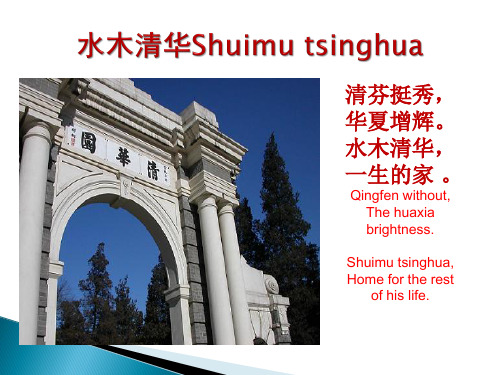
第一是耻不如人。 第二是讲究科学。
第三是重视实干。
The first is no disgrace. The second is to pay attention to science.
The third is the attaches great importance to the work.
清华大学的前身是清华学堂,始建于1911年,当时是由美国
“退还”的部分“庚子赔款”建立的留美预备学校。1912年,清华学 堂更名为清华学校。以清华国学研究院四大导师王国维、梁启超、陈 寅恪、赵元任以及李济等为代表的清华学者,主张“中西兼容、文理 渗透、古今贯通”,形成了著名的“清华学派”,对清华的发展产生 了深远的影响,培养出了一大批高水平的学术大师。 Predecessor is tsinghua school of tsinghua university, founded in 1911, was part of the "refund" by the United St" establish preparatory school to stay in the United States.
清芬挺秀, 华夏增辉。 水木清华, 一生的家 。
Qingfen without, The huaxia brightness.
Shuimu tsinghua, Home for the rest
of his life.
做一个高尚的人,在气节、操守、品 德、治学等方面都应不屈不挠,战胜自我,永 远向上,力争在事业与品行两个方面都达到最 高境界。
在做人做事方面应该顺应自然,胸怀 博大,宽以待人,承担起宏伟的历史任务
Do a man of noble, in such aspects as moral integrity, integrity, character, research should be indomitable, defeat oneself, forever upward, strive to be career and conduct both reached the highest realm. In terms of we should comply with the nature, the mind, forgive, to undertake the historical mission of grand
高校英文译名套路

高校英文译名套路为什么“师范大学”译成normal,清华大学是Tsinghua?高校英文译名套路真多!How to translate these Chinese universities' name into English为什么“师范大学”译成normal,清华大学是Tsinghua?高校英文译名套路真多!How to translate these Chinese universities' name into EnglishChina Daily 2022年-07-11 09:00为什么北京师范大学是Beijing Normal University?清华和北大为啥是Tsinghua University和Peking University?上海交通大学为什么直接音译为Shanghai Jiao Tong University?高校英文译名套路多,双语君(微信ID:Chinadaily_Mobile)和大家一起盘点中国大学英文译名有几款。
1以地名命名以地名命名的综合性大学最为常见,这类大学的英译通常没有争议,采用中规中矩的中文拼音作为英文译名。
南京大学Nanjing University (NJU)浙江大学Zhejiang University (ZJU)2以专业特色命名外语类大学、工业大学、财经大学等以专业特色命名的大学在翻译校名时往往会加入相应专业特色。
比如:外国语大学通常采用foreign studies或international studies 的译法;“工业”的译法处理为technology或polytechnical;“财经”则直译为finance and economics。
上海外国语大学Shanghai International Studies University (SISU)北京外国语大学Beijing Foreign Studies University (BFSU)北京工业大学Beijing University of Technology (BJUT)西北工业大学Northwestern Polytechnical University (NPU)上海财经大学Shanghai University of Finance and Economics (SUFE)3师范大学为什么译作normal university我国师范类高等院校的英文校名基本译为normal university/ college。
985各高校简介及历年录取分数线
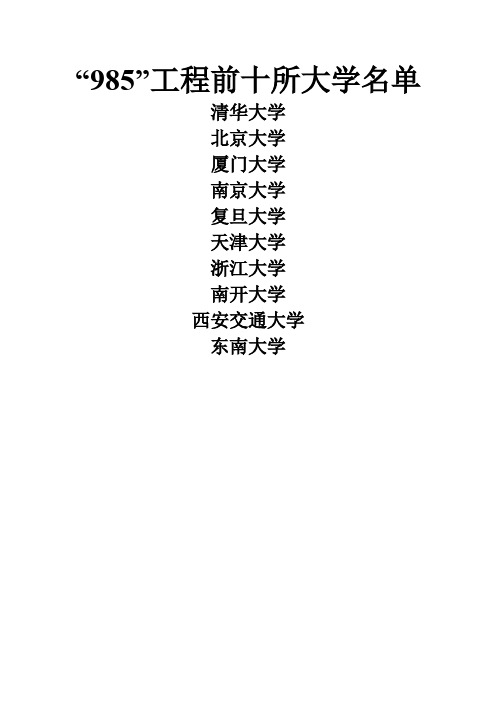
“985”工程前十所大学名单清华大学北京大学厦门大学南京大学复旦大学天津大学浙江大学南开大学西安交通大学东南大学清华大学清华大学(英文名:Tsinghua University),简称"清华",地处北京西北郊繁盛的园林区,是在几处清代皇家园林的遗址上发展而成的。
清华大学的前身是清华学堂,始建于1911年,曾是由美国退还的部分庚子赔款建立的留美预备学校。
1912年,清华学堂更名为清华学校。
1925年设立大学部,开始招收四年制大学生。
1928年更名为国立清华大学,并于1929年秋开办研究院。
目前,清华大学设有16个学院,56个系,已成为一所具有理学、工学、文学、艺术学、历史学、哲学、经济学、管理学、法学、教育学和医学等学科的综合性、研究型、开放式大学。
清华大学是中国大陆地区的著名高校,工学、管理学、理学、经济学、传播学、法学、医学、哲学、文学、艺术学、历史学等都是它的强项。
清华是中国政府重点支持建设的两所大学之一,国家首批“211工程”和“985工程”系列的重点大学,是九校联盟(C9)的成员。
清华是亚洲和世界最重要的大学之一。
清华是中国大陆高考竞争最激烈的大学之一,每年只有中国各省市高考成绩最优秀的高中毕业生才有机会被清华录取。
清华大学的本科生,毕业后一部分到美国的院校攻读博士学位。
据《高教年鉴》报道,2006年清华是获得美国院校博士学位最多的本科生生源院校榜首。
校容校貌校园内绿草青青,树木成荫,湖光山色,景色优雅,各个不同时期的建筑自然形成各具风格的建筑群落,为师生创造了适宜的工作、学习、生活环境。
清华园大礼堂的草坪前日晷上在风雨中挺立数十载,上面刻着清华的校风:“行胜于言”。
“行胜于言”不是不言,而是言必求实,以行证言。
清华园水木清华清华大学在安徽地区文科录取分数线北京大学北京大学(英文名:Peking University),简称“北大”。
初名京师大学堂,是中国近代第一所国立大学,以最高学府身份创立,最初也是当时中国最高教育行政机关,行使国家教育部职能。
清华大学TsinghuaUniversity
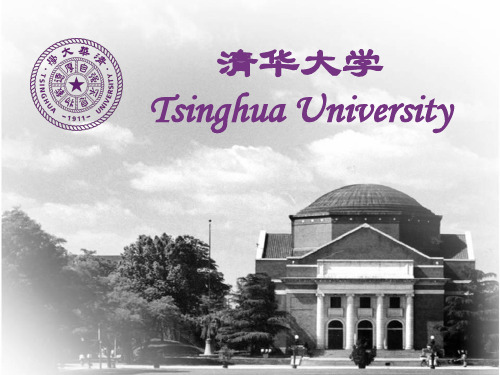
Patents and Publications
Patents
Year
2019 2019 2019 2019 2019 2019 2019
Other departments
Environmental Science and Engineering //
Electrical Engineering and Applied Electronic Technology //
Engineering Physics // Chemical Engineering // Material Science and Engineering
School of Mechanical Engineering
Mechanical Engineering // Thermal Engineering //
Precision Instruments and Mechanology// Automotive Engineering // Industrial Engineering
1,172 1,125 1,380
36
32
Education Programs
62 Undergraduate Programs 249 Master’s Programs 228 Doctoral Programs
Student Number
Full-time student Undergraduate Graduate
Centre
清华大学TsinghuaUniversity16页PPT
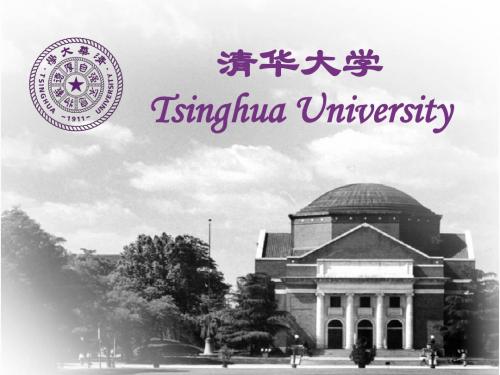
Management
School of Economics and Management
Management Science and Engineering Technology Economics and Management Finance Economics Accounting Business Strategy and Policy Human Resources and Organizational Behavior Marketing
of engineering 1978-2000 – Restructed into a comprehensive
university Now – 15 schools, 56 departments
15 Schools
School of Information Science and Technology School of Mechanical Engineering School of Aerospace School of Civil Engineering School of Architecture School of Sciences School of Medicine School of Law School of Economics and Management School of Public Policy and Management School of Marxism School of Humanities and Social Sciences School of Journalism and Communication Academy of Arts and Design School of life sciences (2009.10.28)
- 1、下载文档前请自行甄别文档内容的完整性,平台不提供额外的编辑、内容补充、找答案等附加服务。
- 2、"仅部分预览"的文档,不可在线预览部分如存在完整性等问题,可反馈申请退款(可完整预览的文档不适用该条件!)。
- 3、如文档侵犯您的权益,请联系客服反馈,我们会尽快为您处理(人工客服工作时间:9:00-18:30)。
Mechanical Engineering // Thermal Engineering //
Precision Instruments and Mechanology// Automotive Engineering // Industrial Engineering
School of Marxism School of Journalism and Communication Academy of Arts and Design
Textile & Fashion Design // Ceramic Arts and Design // Industrial Design // Visual Communication Desimation Art and Design// Painting Sculpture // Art & Crafts //Art History//
Other departments
Environmental Science and Engineering //
Electrical Engineering and Applied Electronic Technology //
Engineering Physics // Chemical Engineering // Material Science and Engineering
Engineering Faculties
School of Information Science and Technology
Electronic Engineering // Computer Science and Technology// Automation // Microelectronics and Nanoelectronics
of engineering 1978-2000 – Restructed into a comprehensive
university Now – 15 schools, 56 departments
15 Schools
School of Information Science and Technology School of Mechanical Engineering School of Aerospace School of Civil Engineering School of Architecture School of Sciences School of Medicine School of Law School of Economics and Management School of Public Policy and Management School of Marxism School of Humanities and Social Sciences School of Journalism and Communication Academy of Arts and Design School of life sciences (2009.10.28)
Sciences, Medicine, Architecture, Law Faculties
School of Sciences
Mathematical Sciences // Physics // Chemistry
School of Life Sciences
Biological Sciences and Biotechnology
School of Aerospace
Aerospace // Engineering Mechanics
School of Civil Engineering
Civil Engineering // Construction Management // Hydraulic and Hydropower Engineering
清华大学 Tsinghua University
History
1911 – Tsinghua School 1928 – National Tsinghua University 1937-1946 – Moved to Kunming,
“Southwest Associated University” 1952 – Became a multi-disciplinary university
School of Law
Management
School of Economics and Management
Management Science and Engineering Technology Economics and Management Finance Economics Accounting Business Strategy and Policy Human Resources and Organizational Behavior Marketing
School of Medicine
Medicine // Pharmacology // Biomedical Engineering
School of Architecture
Architecture // Urban Planning & Design // Building Science and Technology // Landscape Architecture
School of Public Policy & Management
Liberal Arts
School of Humanities and Social Sciences
Philosophy // History // Sociology // Political Science // International Relations // Psychology // Foreign Languages // Chinese Language and Literature
